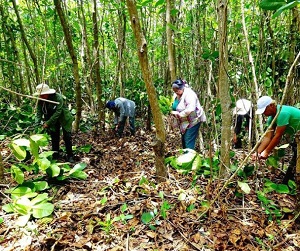 A total of 323 plants had been identified as invasive alien species in Cuba, which have the potential to impact biological diversity and affect agricultural production. Boasting an estimated 7,000 to 7,500 plant species, of which some 53% are exclusive to the archipelago, Cuba is one of the islands with the greatest diversity of plants and endemism in the Caribbean and the world.
A total of 323 plants had been identified as invasive alien species in Cuba, which have the potential to impact biological diversity and affect agricultural production. Boasting an estimated 7,000 to 7,500 plant species, of which some 53% are exclusive to the archipelago, Cuba is one of the islands with the greatest diversity of plants and endemism in the Caribbean and the world.
Nevertheless, a Red List of Cuban Flora was compiled in 2016, by a group of scientists affiliated with the University of Havana’s National Botanical Garden; the Ministry of Science, Technology and Environment’s Institute of Ecology and Systematics; the National Center for Protected Areas; the University of British Columbia, in Canada; and the Holguin Botanical Garden, revealing that approximately half of the 4,627 plant species evaluated in the research project were in danger of extinction.
Human activity is mainly responsible for this dire situation, with deforestation, livestock ranching, agriculture, and the presence of invasive alien species having the greatest impact.
Dr. Ramona Oviedo Prieto, researcher at the Institute of Ecology and Systematics, and an authority on the subject, discussed this last threat with Granma International, explaining that the term “invasive alien species” refers to plants from other places introduced intentionally or not by human beings, which have adapted to the environment and are capable of reproducing prolifically and extending their habitat beyond the area where they were first planted.
As the expert explained, these species impact biological diversity, particularly endemic flora and ecological functions, as well as altering the landscape, and affecting agricultural and forestry production.
They can also adversely affect the quality of soil and water. Some of these plants even play a role in transmitting diseases to humans, she noted.
According to the findings of research projects carried out in several stages by a group of scientific entities under the direction of Dr. Ramona Oviedo, members of her team and collaborators, by 2001 a total of 323 plants had been identified as invasive alien species in Cuba.
It was possible to define the 100 most aggressive for our archipelago, based on the magnitude of damages they cause to native biota and a variety of productive activities, also taking into consideration the degree to which they have spread across the country.
The list of these alien species is headed by marabou, and includes the Australian pine, rose apple, ipil-ipil, vachellia aroma, African tulip, and cajeput, all to be found in terrestrial environments, while water plants in this category include water hyacinths and miriofilum, among others.
Considering the importance of permanently monitoring the devopment of this environmental problem, the National Herbarium Working Group, attached to the Institute of Ecology and Systematics, is updating the national inventory of alien invasive and potentially invasive plants, focusing on those with greater incidence or aggressiveness in natural, semi-natural, and agricultural ecosystems, recognized for their biological diversity, landscape value, and economic contribution.
Although this arduous, ongoing task has not yet been completed, preliminary results for the period 2015-2019 reveal 35 new reports of alien invasive and potentially invasive plants, of which 10 are new to most of the West Indies.
Other findings include 25 possible changes in the aforementioned classification and modifications to the list of the most aggressive species and those of greatest presence in different ecosystems and environments, in order to determine if they maintain the same status, or if not, make required adjustments.
According to Dr. Ramona Oviedo, the collection of new complementary information will help to fill the gaps in knowledge that were noted in the research carried out between 2007-2011 and 2012-2014, including aspects related to geographical distribution, damage to ecosystems, and dispersal and propagation mechanisms.
The expert stressed that new harmful effects associated with these species have been detected recently in several agro-industrial activities.
“One of the most worrisome is related to difficulties that exist in a significant number of sugarcane fields where mechanized harvesting is affected by the increasing invasion of woody species, such as the Indian carob tree, other albizias and leucaenas.”
She emphasized that with the participation of a group of scientific, and environmental management experts, teaching and productive institutions, today steps are being taken to improve management and control of the most harmful and widely-dispersed invasive plants.
She noted the example of a pilot project to recover biological diversity, which is underway in the border forests of wetlands in the southern reaches of the provinces of Artemisa and Mayabeque, through natural regeneration and planting of native species, while at the same time, work is being done to reduce the presence of several invasive plants well established in the area, in particular almonds, casuarina and leucaena.
All of this research and the application of findings are among tasks outlined in National Biodiversity Targets 2016-2020, the Global Strategy for the Conservation of Plant Species 2011-2020, and the Aichi Goals, in addition to contributing to the implementation of Tarea Vida, the national plan to confront climate change.
(Granma)